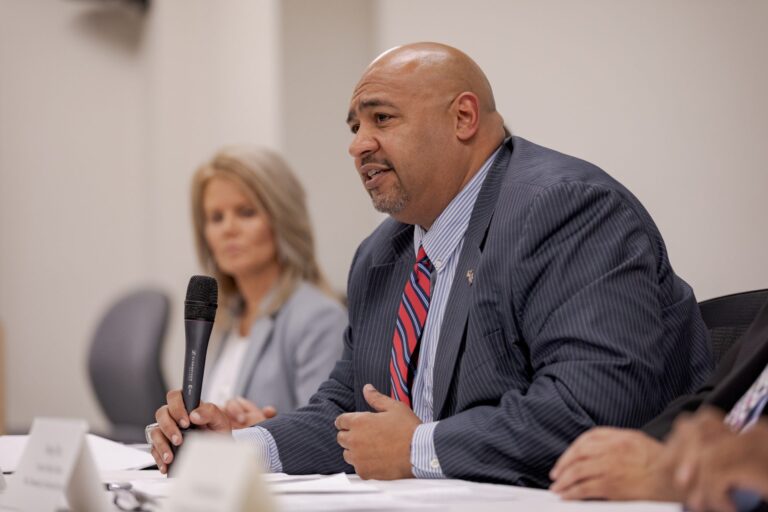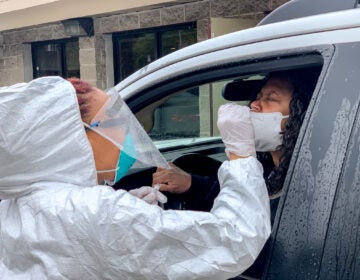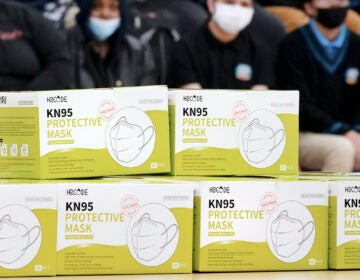As counties reopen, what about the correctional facilities inside their borders?
Inmates in prisons and jails remain on lockdown. And without proper testing, public health experts say that can’t end anytime soon.

Secretary of Corrections John Wetzel discusses results of an internal review of parole cases that involved recent homicides or attempted homicides, during a press conference in Mechanicsburg on Wednesday, August 28, 2019. (Commonwealth Media Services)
This story originally appeared on PA Post.
Without a plan to test Pennsylvania’s incarcerated population for coronavirus or antibodies, public health experts say that prisons lack an essential guidepost to begin easing restrictions put in place two months ago to protect prisoners and guards from exposure. And without tests, they say there’s no safe way to allow prisoners to go back to regular routines, such as working jobs, exercising and attending classes.
People who live and work in correctional facilities continue to be among the heaviest impacted by the coronavirus, with more than 200 positive COVID-19 cases in state prisons and hundreds of infections, collectively, throughout county jails. Infection rates in some of those facilities triple that of entire counties.
Much of that has to do with penitentiary design and population density, igniting a push by prisoners’ rights advocates and public health leaders to push for mass decarceration.
And while counties have been able to reduce the number of people they jail, there has been less effort by the Wolf administration to release the 12,000 inmates that the Department of Corrections said is needed to be sure COVID-19 doesn’t continue spreading inside state correctional institutions.
The governor announced plans at the beginning of April to temporarily release up to 1,800 state prisoners. As of last week, only 150 have been released.
In lieu of releasing large numbers of inmates, epidemiologists say there needs to be more testing inside correctional facilities for people who aren’t showing symptoms. They say once inmates are identified as being positive, or having antibodies, less stringent restrictions can be applied to them.
But some in the public health community are skeptical that the administration will conduct any of those tests, since the governor continually bucks the idea of mass testing in prisons. Pressed on the question of mass testing during his daily coronavirus media briefings, the governor said they would only continue symptomatic testing of inmates.
“We’ve responded aggressively to stop cruise ships from running and college dorms from having students, but for jails and prisons we’ve thrown up our hands and said there’s not much we can do,” said Joseph Amon, director of the Office of Global Health at Drexel University. “The strategy has to be continuing to look at antibody testing and releasing detainees who don’t need to be incarcerated.”
At the state level, the corrections department’s early mitigation strategy — locking down facilities to minimize the potential for outsiders to bring the virus in or inmates to spread to each other and staff — was arguably effective, compared to other states. Pennsylvania, which has the 5th largest prison population in the country, ranks in the middle of the pack when it comes to coronavirus rates in its jails and prisons. Compare that to Tennessee with the state’s 13th largest prison population and has the highest infection rate in the country, with 9,262 cases per 100,000 inmates.
Still, the state’s rate of positive COVID-19 cases is significantly higher than Philadelphia, the state’s hotspot, and far beyond the threshold of the 50 cases per 100,000 that counties must meet to move into a yellow phase.
The governor’s phased reopening specifically states that prison restrictions should remain in place until a county completely reopens. But with inmates on 23-hour lockdowns in tiny two-person cells, that solution isn’t tenable – especially for inmates with mental health issues.
“You can get away with that for a couple weeks,” said Department of Corrections Sec. John Wetzel during a media call last month. “At some point you can’t keep people locked down.”
And as correctional facilities reach week seven of lockdown, the Department of Corrections this week said its putting together a plan to guide state prisons to regular operations. That plan, the department said, will trail the governor’s decision to reopen counties.
But without mass testing for both antibodies and the coronavirus, experts say easing lockdowns in prisons is unlikely to happen any time soon and deferred until well after counties fully reopen.
“This will happen for a long time until we’re comfortable treating this or have a vaccine,” said Brun Mathema, an assistant professor of epidemiology at Columbia University’s Mailman School of Public Health.
Mathema said that there needs to be a “suite” of plans, and pointed to antibody testing as an important tool to guide corrections officials.
“It’s a very interesting and exciting accessory,” he said, referring to the increasing availability of tests that can reveal whether a person has been exposed to the coronavirus in the past and recovered. “But we need to know more about it. We need to know what that actually means for immunity.”
PA Post reached out to half a dozen county jails that have already moved into the yellow phase of the governor’s reopening plan to also know what they had in place to ease lockdown restrictions. None of the facilities that responded confirmed that they expected to move out of lockdowns. And though the state corrections department doesn’t oversee those facilities’ operations, many wardens are looking to mirror what the state does.
“The governor’s guidance clearly says that congregate care and prison restrictions remain in place,” said Orlando Hooper, Warden for the Allegheny County Jail, adding that they’ll follow the lead of the state.
But inmates’ rights groups and their advocates say that there should have been a plan for counties and prisons well before reopening.
“We would hope that some degree of increased movement and programming would accompany the move to the yellow phase,” said Claire Shubik-Richards, executive director of the Pennsylvania Prison Society, the state’s unofficial ombudsman between inmates and correctional institutions. “I’m disappointed that with a two-week lead time, they haven’t been able to implement what a yellow phase is going to look like already.”
And without those tests or plans in place, there’s no conceivable way jails or prisons can move forward with life as normal.
WHYY is your source for fact-based, in-depth journalism and information. As a nonprofit organization, we rely on financial support from readers like you. Please give today.




![CoronavirusPandemic_1024x512[1]](https://whyy.org/wp-content/uploads/2020/03/CoronavirusPandemic_1024x5121-300x150.jpg)


